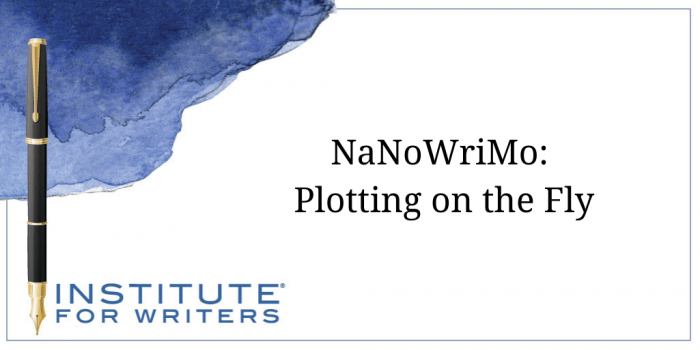1000 N. West Street #1200, Wilmington, DE 19801
© 2024 Direct Learning Systems, Inc. All rights reserved.

Hello, NaNoWriMo-ers! By the end of today, your NaNoWriMo novel should be around 16,670 words. If it’s not, try and pick up some extra time this week so you don’t fall too much more behind. You can do it. Just a few more hundred words a day might be all it takes.

There are countless books and theories on the best way to plot. You are going to have to find what works for you. I use a little bit of everything. For the purpose of NaNoWriMo, however, I don’t want you studying up on how to plot. This month is for writing. I’ll let you in on a little secret. You already know how to plot. Every one of us is a storyteller. We know how to do this instinctively. We just forget that sometimes or become bogged down with minutiae and labels.
Two types of writers you always hear about are “Plotters” and “Pantsers.” Plotters write down an outline that will take their book from beginning to ending. Most of the time these outlines are fluid, but some people prefer to have them written in stone before beginning. Pantsers, on the other hand, just sit down and write, letting the story come organically. A lot of Pantsers say if they know how the story is going to end, they get bored and lose their motivation to write it. I think we’re all a little bit of each. Forget about Plotting and Pantsing, though.
To continue your NaNoWriMo book when you get stuck, you need to know four things:
1. Where to start?
2. Where does it all fall apart?
3. How does it end?
4. What has the protagonist learned?
Have you nailed the opening? Do you have your “meet cute,” if you’re writing a romance? Are you stuck on the beginning chapters? If so, I recommend having your characters meet right off the bat. If they can be in conflict, that’s even better. You want to open up with a hook that keeps the reader turning the pages. You want to gain the reader’s sympathy right away for your characters. You want to set the tone of your novel right off the bat. You need to make it obvious what genre it is from the first scene.
If you’re writing an adventure, put your main character in trouble asap. Let the danger begin. If it’s a mystery you’re writing, set it up on the first page. Make your reader wonder as you drop clues. Remember, this month is for writing, so don’t worry about the details; details can be ironed out in revision.
This is your black moment when all hope is lost. In the romance novel, it’s when the couple breaks up and goes their separate ways. In the mystery novel, it’s when the thief or murderer seems to have gotten away with it. No matter what genre you’re writing, this is the turning part of the book. You want your characters to suffer, because that’s what’s going to keep the reader hooked. Spend some time being like Dr. Evil, and think of ways you can torture these fictitious victims.
This is the easiest for the genre novel. We know that in the end of a romance novella, the hero and the heroine are going to overcome their obstacles and live happily ever after. Check! In the mystery novel, the crime is solved. Check! So now you only have to figure out how are you going to get there. Jotting down a few scene ideas may help you break out of or avoid a writing slump.
Your hero and heroine have to change. The characters we meet tussling in the first scene must be irrevocably changed by the novel’s events by the time we write “The End.” They have to complete their internal arcs and have learned more about themselves to become happier and fulfilled. The story arc or the external arc have to be concluded as well. What will your characters learn by the end of the story? (Without making it a pedantic lesson.)
Spend a few moments brainstorming on these arcs and how your characters or their situations will change throughout the novel. But be careful about getting bogged down by all the terms. It’s easy to get overwhelmed thinking, “What is my inciting incident?” When chances are you already know what it is. You just didn’t label it as such.
In the end, don’t give up. Keep writing and thinking. You can do it. We’re almost to the halfway point. There’s no turning back now.
Good luck and good writing!
USA Today bestselling author, Jamie K. Schmidt, writes erotic contemporary love stories and paranormal romances. Her steamy, romantic comedy, Life’s a Beach, reached #65 on USA Today, #2 on Barnes & Noble and #9 on Amazon and iBooks. Her Club Inferno series from Random House’s Loveswept line has hit both the Amazon and Barnes & Noble top one hundred lists. The first book in the series, Heat, put her on the USA Today bestseller list for the first time, and is a #1 Amazon bestseller. Her book Stud was a 2018 Romance Writers of America Rita® Finalist in Erotica. Her dragon paranormal romance series has been called “fun and quirky” and “endearing.” Partnered with New York Times bestselling author and actress, Jenna Jameson, Jamie’s hardcover debut, SPICE, continues Jenna’s FATE trilogy.
1000 N. West Street #1200, Wilmington, DE 19801
© 2024 Direct Learning Systems, Inc. All rights reserved.
1000 N. West Street #1200, Wilmington, DE 19801
© 2024 Direct Learning Systems, Inc. All rights reserved.
1000 N. West Street #1200, Wilmington, DE 19801
© 2024 Direct Learning Systems, Inc. All rights reserved.
1000 N. West Street #1200, Wilmington, DE 19801
© 2024 Direct Learning Systems, Inc. All rights reserved.

1000 N. West Street #1200, Wilmington, DE 19801
© 2025 Direct Learning Systems, Inc. All rights reserved.

1000 N. West Street #1200, Wilmington, DE 19801
©2025 Direct Learning Systems, Inc. All rights reserved. Privacy Policy.
2 Comments